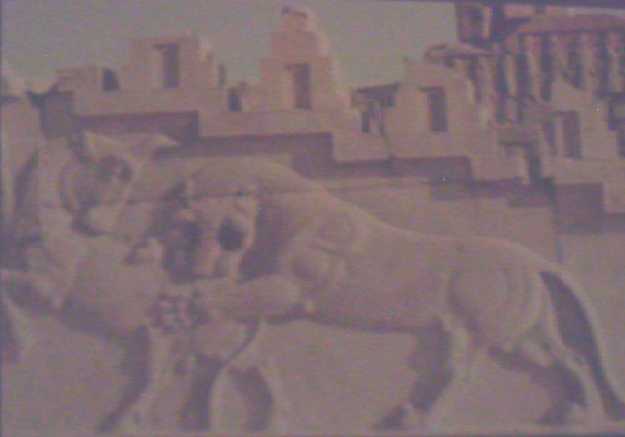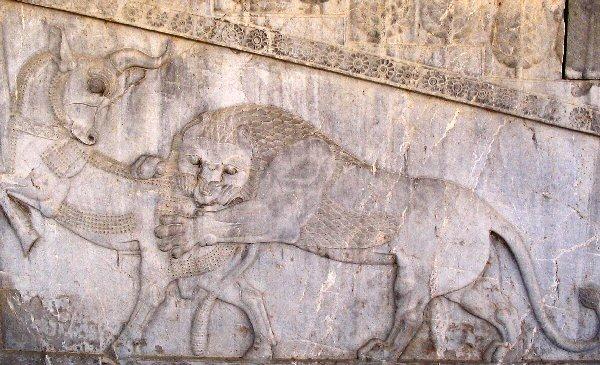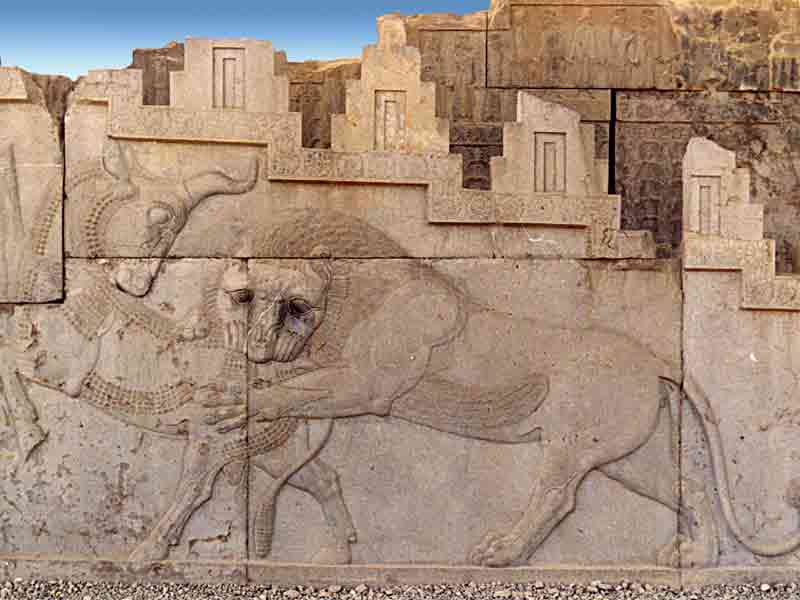Unicorns in iraq? |
Intro |
|
Well I've always been fascinated with the mythology of unicorns. It stretches all over the world and it can be seen in art ancient and modern worldwide. Quite why the same creature can be imagined, drawn and tales made involving it by completely seperate peoples and yet be so similar in content is a mystery indeed.
The particular piece of art that led to this little webpage started when I found an old 18 x 12 inch color photo which must have been taken from a slide film as its exceptional quality. I liked it because I saw this as a picture of a Lion biting the ass of a Unicorn. I discovered it while doing my usual trawling through odds and ends in my local charity shop. Here is a digital image of the photo that I have. My photo is actually much better quality than the ones I found on the internet. This image does not do it justice at all really, but it serves its purpose as an illustration of my starting point. This is my novice attempt at taking a photo of it with a reasonably priced digital camera (photo on a music stand, camera on a tripod). |
 |
. |
Unicorn or Gazelle? |
|
Later on having found nothing even close under a search for unicorn, I decided to replace the search with Gazelle instead as this at the time is the common oppinion of what these pictures/pieces of art illustrate.
Interestingly, I found this piece of translated ancient poetry/verse: Every morning in Africa, a gazelle awakens. He has only one thought on his mind, To be able to run faster than the fastest lion. If he cannot, then he will be eaten. Every morning in Africa a lion awakens. He has only one thought on his mind, To be able to run faster than the slowest gazelle. If he cannot, he will die of hunger. Whether you choose to be a gazelle or a lion is of no consequence. It is enough to know that with the rising of the sun, you must run. And you must run faster than you did yesterday or you will die. This is the race of life. - African Proverb Looking at the people in the background of the picture; They apear to be walking or marching hand in hand in a single line. Are they traveling along the journey of life in a way which would not be as direct if they weren't hand in hand / together? Is there some similar cultural wisdom/proverb depicted in this part? |
. |
Asking the help of others. |
|
Then I went to an online chat website and asked someone if he could help me trace whereabouts this picture came from. He said that there was something similar in the UK Museum, so I did another search and finally found something very similar, the image below at The Apadana Stairs, Persepolis, Iran. Finally i'd found some artwork which very closely resembled my photo.
image taken from: BioFelk.cvut.cz |
 |
. |
Excited, I delved deeper... |
| So I carried on the search and found something even closer: image taken from: Livious.org |
 |
. |
Becoming a tourist. |
|
So I was fairly certain I'd found the right place, just didnt seem that I could find a photo taken from the same view. So I carried on searching, looking back through the results before and found a tourist website. So I thought i'd look further and hey presto I found it. At the bottom of the tourist website page that came up in the search engine was a link to thier gallery which did have the exact view and confirmation that I was looking for.
image taken from: FarsTourism |
 |
. |
Below is text taken from FarsTourism describing what can be found there. |
PersepolisThe Pars was one of the important sects of Aryans, who formed a government after coming to Iran. The Pars dynasty has been known as a powerful dynasty in the resources. The last king of Medes, Asitag, was obliged to fight against one of the Pars by the name of Cyrus. According to the resources they were relatives. In this war Astiag lost the war and Cyrus established a new kingship known as the Achaemenian. The first capital of the Achaemenian was Pasargad. Cyrus made this place a flourished one. But after his death this city lost its importance gradually. Until Darius the first got the power and as Pras territory was very important for the Achaemenian, he established his capital at the foot of Rahmat Mountain and overlooking Marvdasht Flat which had historical backgrounds. Persepolis was actually a capital and ceremonial palace, which was only used for the important and special ceremonies such as Nawrooz or a temporary residence. The Achaemenian used to spend the rest of the year in the ancient city of Hegmataneh (in summer) and the old capital of Elamite, Shush (in winter). After Darius other kings of the Achaemenian added new constructions to the one that he had started, so it took about 150 years to complete the constructions. The main constructions were built on a stone platform and all the palaces were surrounded from the north, the south and the west by a great stone wall. Outside the platform and about 500 meters after the wall some buildings had been built for viziers, courtiers and advisors. The whole construction is about 135 thousand square meters. The buildings that were used for formal, national and religious ceremonies were very vast and had wide gates such as the Apadana Palace and the one hundred-column hall. Other buildings that were used as the residence of the king, queen, royal dynasty and guard stands were smaller. The most important constructions of Persepolis are: The grand entrance stairs: the only way of access to the upper part of the palace is by a great double flight of stairs, which is made of huge white stones. The total number of the steps is 110 and every four or five steps are cut out of one block of stone. There is a stone balustrade beside the stairways as high as 75 centimeters and is an adaptation of Zigurats of Sumerian. The Gate of Nations: the first building over the platform, which is located at the distance of 20 meters from the entrance stairway, is a hall with an area of 600 square meters. Four stone columns, only two of which remain in position, supported the roof of this building. This hall had a stone bench on all four sides, which were used by the guests as seats. The guests, before entering the Apadana palace, used to wait in this hall. As the guests came from different nations, this place is called the Gate of Nations or the Waiting Hall. The hall had three wide doorways of which the eastern and western consisted of stones of great weight with reliefs on them, depicting mythical creatures. Apadana: the finest palace in Persepolis from the point of view of size, height and the technique and skill displayed by the architects in the construction of different parts is Apadana Palace. This palace is situated on an upper section of the platform facing the wide and beautiful flat of Marvdasht. It was used for festivals and official receptions. The central hall had an area of 3600 square meters and 36 solid stone columns as high as 18 meters. On three sides of the hall, the east, west, and north, there were three porches with the same height as the hall, each of which had 12 columns. So as a whole Apadana had 72 columns. On the southern side where there was no porch, there were small rooms and halls used by palace guards and court officials. The interesting parts of the Apadana Palace are two flights of steps, situated in the north and east of the building. Fortunately the soil washed down during centuries protected the eastern staircase so that it has remained practically untouched, but the northern staircase has damaged alot. The engravings on Apadana stairs are the most beautiful ones in Persepolis. They show the representatives of 23 countries and provinces, which were under the jurisdiction of the Achaemenian kingdom, bearing offerings, dues or the products of their countries in their hands. The gifts, the clothes of the representatives, the faces and other things are engraved beautifully in this relief. All the eastern porch capitals were decorated with the statue of a two-head lion and the western porch capitals with the statue of two-head cows. The Hundred-Column Palace: this palace is known as the largest hall of Persepolis. It was built by order of Xerxes and as it has 100 columns, it is known as The Hundred-Column Palace. Each of the columns is 12 meters high. This palace is located in the eastern part of Apadana Palace and has eight doorways. One of the interesting things in this palace is the engraving on the stone walls of the doorways. They show 28 representatives of the subject nations bearing the king throne over this relief and at the back of the king, there stands an especial attendant. There are some engravings in the eastern and western doorways, depicting the king fighting against a mythical animal. On the eastern side of the hall are walls made of sun-dried bricks, Which probably were used as a place to keep the royal chariots and horses. There were small rooms in the other part of the palace, which belongs to the palace guards and the attendants. The Central Palace: one of the other palaces in the southeast of Persepolis is a rectangular palace which is called the Central Palace, as it is situated in the center of the other palaces of Persepolis. This palace had 2 pillared porches in the north and had 3 big doorways in which there were engravings similar to ones you see in Hundred-Column Palace. One of the interesting decorations of the palace is the great staircase in the north, which leads to the area opposite the Apadana Palace. The southern and northern porches were decorated with capitals in the shape of a human head with the body of an animal. Tachar: it is situated in the south of Apadana Palace, and due to one of its inscriptions, which has the word Tachar, it is called by this name. The windows of this palace, unlike the other palaces were towards the sun, so it was probably a winter palace. This palace is known as the private palace of Darius the First. The way into the private palace of Darius was through two flights of stairs in the south and west. This palace is built of highly polished stones and that’s why it is also called Hall of Mirrors. There is an inscription in the southern porch in three languages, old Persian, Elamite and Babylonian, imputing the constructing to Darius the First and the completion of the palace to Xerxes. The engravings here like other engravings of the Persepolis are delicate and exact, depicting representatives of the countries carrying some offerings such as mountain goats, gazelle and etc. There are short inscriptions in cuneiform in the borders above and around the stone window frames and recesses, most of which bear the name of Darius. The remains of gypsum on the floors of the northern rooms show that this material used to cover the floors. There are several other inscriptions from other kings of Iran such as Sassanid Shapur II, Azed al Dawleh Deilami, and Nasereddin Shah Qajar. Hadish: the private palace of Xerxes is called Hadish, and this name has come in the inscriptions of this palace. It is situated in the upper part of the platform of Persepolis. It consists of a central hall with 36 columns, the northern porch with 12 columns and a porch in the south with some small rooms in the eastern and western parts. In the entrance doorway, the figure of Xerxes with his attendants has been carved. A point to notice in this palace is the engraving on the windows depicting some persons carrying their presents for the king, that you can not see in other palaces. A system of underground watercourses collected the rain off the roofs of this palace and conveyed it to the main canals. Haremserai (the queen’s palace): The building made of sun-dried brick in the south of Hadish is known as Haremserai or Andaruni. It is supposed that the royal ladies resided there. The plan and the design of the building are somehow like that of the central hall of Tachar Palace. In the southern part of this building an inscription was found propounding how Xerxes became the king. Today this building is used as a museum and it is a place for keeping things discovered in the course of digging. Treasury: there is a building made of sun-dried brick in the east at the foot of Mount Rahmat. Since a number of stone and marble vessels and ornaments were found in the course of excavation, the place is called Treasury. The Treasury consists of two large halls with wooden columns. There were about 100 columns in this place and all the rooms, corridors and porches were made of sun-dried bricks. The thresholds of the doorways and the bases of the pillars were all made of polished stones. An avenue as wide as 5.50 meters surrounded this set of buildings. Other interesting places in Persepolis are, the quarter for the guards and watchmen at the foot of the Mount Rahmat, the stone well on the slope of Mount Rahmat and the buildings made of sun-dried bricks on the northern wall, which were used as the royal chancellery. The tombs of the Achaemenian kings: the tombs of two of the last Achaemenian kings, Arta-Xerxes the Second and the Third, are in the heart of Mount Rahmat. Along these tombs on right side about 100 meters further, there is another tomb, which has remained incomplete and belongs to the last king of Achaemenian, Darius the Third. The outward appearance and design of the tombs are completely similar to the tombs of the Achaemenian kings in Naghseh-e Rustam. There were some other buildings outside the platform of which no trace has remained, but lots of ornaments have been discovered, which are now kept in Persepolis Museum and other famous museums. |
. |
| DISCLAIMER: Images and text taken for relevence of research purposes only. The owners of the websites where they have been retrieved are welcome to request removal from this site if neccessary. |
. |
| Back to IMDWHISPER |